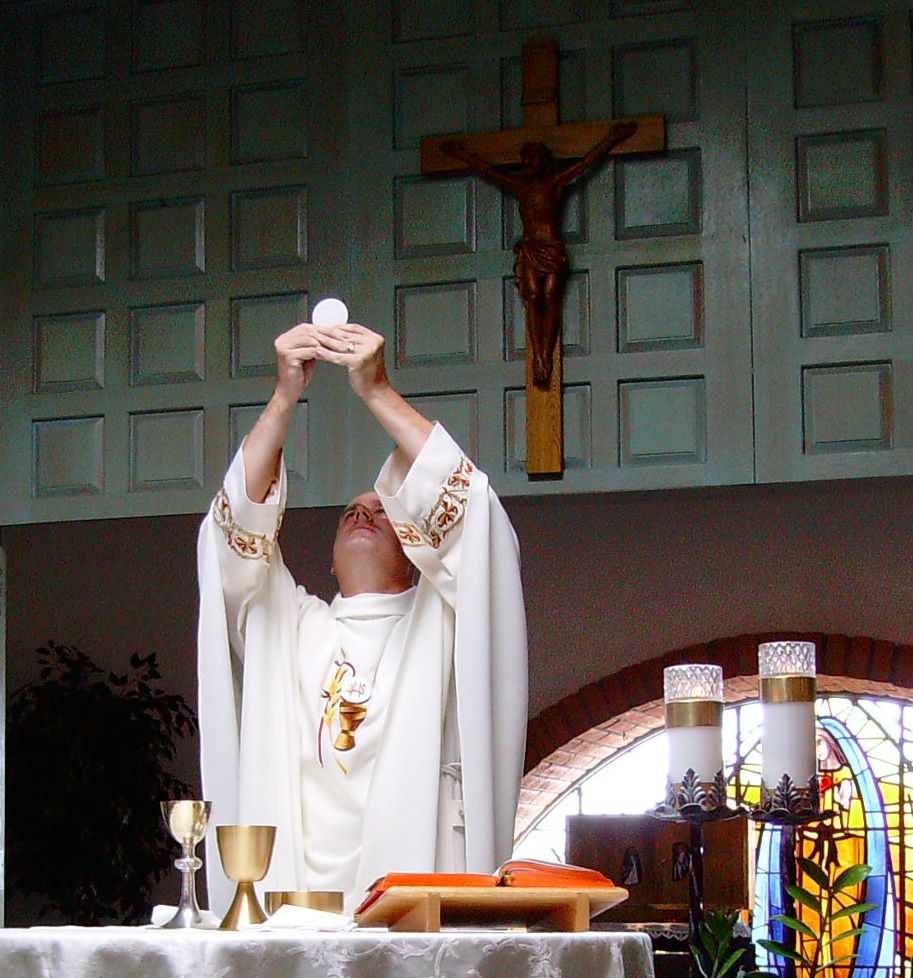Many people are surprised when I tell them St. John Paul II spoke very little about the Eucharist in his Theology of the Body. He also seemed to neglect his favorite saint, the Blessed Mother. There’s not even an invocation or prayer to her, as is the case in so many of his writings.
These uncharacteristic omissions seem mysterious until we remember that the Theology of the Body was originally written as an academic work. As the story goes, the future John Paul II arrived in Rome (as Cardinal Wojtyla) to attend the conclave to elect Pope John Paul I’s successor. With him, he had an almost finished manuscript, one that required only a final editing before it would be ready for publication.
However, Cardinal Wojtyla never left Rome. He was elected pope on October 16, 1978, and faced a publishing dilemma – what should he do with his finished manuscript entitled, “Man and Woman He Created Them”? It was not the kind of academic work that popes usually publish.
In hindsight, history was smiling on Cardinal Wojtyla and all humanity in redirecting the publication of that manuscript. Its dense theological and even mystical language could have reached only an elite circle of academics. Instead, it became the content of Pope John Paul II’s Wednesday audiences over a five-year period (1979 – 1984). During that time, seminarians, housewives, journalists, janitors – people who never would have read “Man and Woman He Created Them” – were exposed to John Paul II’s original, and sometimes jarring, ideas. “Theology of the Body” was birthed into the world one Wednesday audience at a time.
But John Paul II’s development of the Theology of the Body didn’t stop in 1984. In his apostolic exhortation, “The Lay Members of Christ’s Faithful People” (Christifidelis Laici), Pope John Paul II wrote, “The Apostolic Letter on the Dignity and Vocation of Woman [MD]…seeks to again treat and develop the catechetical reflections of the Wednesday General Audiences devoted over a long period of time to the ‘theology of the body…'”
This statement is a goldmine! It tells you and me that John Paul II had more to say about the body’s ability to make a total gift of self in love than what he said in his 129 Wednesday audiences. So, here’s where we pick up on last week’s blog – remember the box of Total cereal? Did you buy a box and prominently display it in your living room this week?
That Total box represents how Jesus Christ loves us. St. John Paul II uses this exact word – total – in Theology of the Body Audience 95b:4, when he says, “…the gift given by God to man in Christ is a ‘total’ or ‘radical’ gift, which is precisely what the analogy of spousal love indicates: it is in some sense ‘all’ that God ‘could’ give of himself to man, considering the limited faculties of man as a creature.”
Here JPII connects two very important concepts: total and spousal. What distinguishes spousal love is the totality of the gift. Spouses give everything to each other, including their bodies, to enter into a union and communion of total, self-giving love with each other. Jesus Christ has given everything to us, including his body on the cross, to enter into a union and communion of total self-giving love with us.
But, there’s more! Christ continues to give his body to us every day through the Eucharist. He is “with us always, even to the end of time” (cf. Mt 28:20). It took many decades for me to understanding that Christ remains with us “always” in a way that is not only spiritual and redemptive, but bodily and spousal. John Paul II says “Christ has entered this [human] history and remains in it as the Bridegroom who ‘has given himself.’ ” (MD, no.25)
Jesus is not just Redeemer, but the Bridegroom Redeemer who remains with His Bride, making the total gift of his Body to His Bride in the Eucharist. In this “remaining” or “abiding” with us as Bridegroom, JPII says, “we find ourselves at the very heart of the Paschal Mystery, which completely reveals the spousal love of God” (MD, no. 26).
Completely reveals the spousal love of God? Do most Christians talk that way? Not in my experience. Normal Christian vocab about redemption usually invokes terms such as sin, shame, paying the debt, forgiveness of sin, appeasing the wrath of God, etc., etc. Can you imagine a Christian world that speaks about Christ as Redeemer and Bridegroom? About forgiveness and spousal union with God? About the sacrifice of the cross prominently displaying the spousal meaning of God’s love? About the Eucharist as the Sacrament of the Bridegroom and the Bride where we are the Bride?
Like the Song of Songs, St. John Paul II’s reflections on the Eucharist and Christ as the Bridegroom of the Church drip with the delicate honey of God’s spousal love for mankind. Line after line of Section 26 of “On the Dignity and Vocation of Women” compete with each other to engrave in our minds and sear into our hearts the spousal love of God for every person by comparing it to the spousal love of husband and wife in which the two become one body.*
I wish you were sitting across from me so that I could read your reaction to these spousal words. Is this new news for you? Is this the first time you are hearing that Christ’s love for you is not only redemptive but spousal? Are you catching St. John Paul II’s drift that redemption is not complete until your body is united to the Body of Christ in the Eucharist in a spousal Holy Communion? Jesus doesn’t want to commune with you just Spirit to spirit or Soul to soul. He wants to be spousally united to you as a husband to his wife. At every Mass, Jesus says to you, “This is my Body given up for you” so that you can receive Christ into your body, and the two, you and Christ, can be “one flesh.”
In encountering these words for the first time (or even the twentieth time), it might seem as if St. John Paul II is being extreme or over-stating his position. However, St. Paul and Ephesians 5:31-32 reassure us of JPII’s orthodoxy when Paul writes, ” ‘For this reason a man shall leave his father and mother and unite with his wife, and the two shall be one flesh.’ This is a great mystery, I mean in reference to Christ and the Church.”
The “great mystery” is not only that husband and wife can become one flesh, but we can become one flesh with Christ in the Eucharist. God created marriage from the beginning to be a symbolic expression of Christ’s spousal love for us, of His total gift of self to us through His body on the cross and in the Eucharist. We need both the cross and the Eucharist to reveal the full meaning of salvation and human embodiment: from the beginning, God created the human body with the stunning capacity for a holy union and communion not only on the natural level through marriage, but on the supernatural level with God through the Eucharist.
If we were to reconfigure marriage so that the one-flesh union of masculinity and femininity is optional, then we tragically eliminate God’s own way of revealing the full truth of Christianity – the spousal truth of God’s love for us and the spousal truth of our human nature created to enter into a holy one-flesh union and communion with the Glorified Body of Christ.
I pray this week you will open yourself to experiencing the spousal love of God through being one body with Christ in the Eucharist along with pondering the irreplaceable meaning of the body as male and female to reveal God’s intimate, spousal love for us. And remember…you are a gift!
*In case you’d like to read the text directly, here is one of JPII’s most condensed “spousal” paragraphs from MD, no. 26, from which I have been drawing for this blog: “We find ourselves at the very heart of the Paschal Mystery, which completely reveals the spousal love of God. Christ is the Bridegroom because ‘he has given himself’: his body has been ‘given’, his blood has been ‘poured out’ (cf. Lk 22:19-20). In this way ‘he loved them to the end’ (Jn 13:1). The ‘sincere gift’ contained in the Sacrifice of the Cross gives definitive prominence to the spousal meaning of God’s love. As the Redeemer of the world, Christ is the Bridegroom of the Church. The Eucharist is the Sacrament of our Redemption. It is the Sacrament of the Bridegroom and of the Bride. The Eucharist makes present and realizes anew in a sacramental manner the redemptive act of Christ, who ‘creates’ the Church, his body. Christ is united with this ‘body’ as the bridegroom with the bride. All this is contained in the Letter to the Ephesians. The perennial ‘unity of the two’ that exists between man and woman from the very ‘beginning’ is introduced into this ‘great mystery’ of Christ and of the Church.”
© Katrina J. Zeno, MTS




